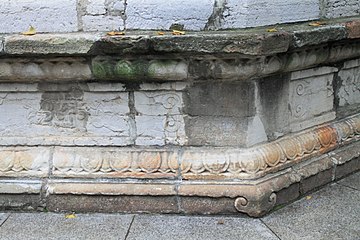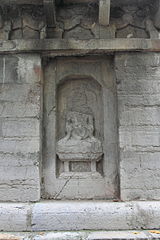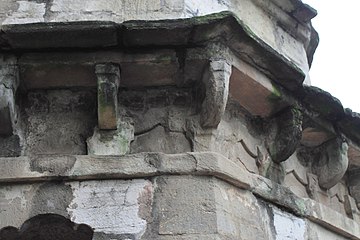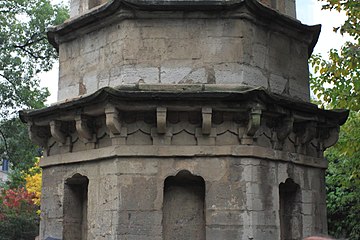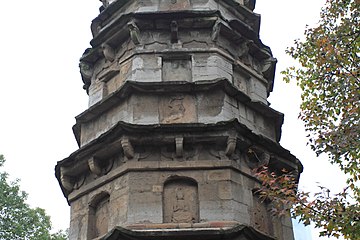Wuying Pagoda
| Wuying Pagoda | |
|---|---|
無影塔 (興福寺塔, 宋興福寺塔, 武漢千年古塔, 洪山無影塔) | |
| Country | China |
Location in Hubei | |
| Geographic coordinates | 30°32′01″N 114°20′05″E / 30.53350°N 114.334800°E |
| Architecture | |
| Completed | 552-4 (original pagoda) 1270 南宋咸淳六年 (rebuilt pagoda) |
| Materials | Stone |
| Wuying Pagoda | |
|---|---|
Hanyu Pinyin | Xīngfúsì Tǎ |
The Wuying Pagoda (
History
Original Pagoda
The origin of Wuying Pagoda stretches back to the later part of the Northern and Southern dynasties period, it having been built during the reign of Emperor Yuan of Liang as part of the Jin'an Temple (晋安寺). Subsequently, during the reign of Emperor Wen of Sui, the temple was renamed Xingfu Temple (興福寺/兴福寺). The pagoda then derived its name from its connection to this temple.
Repeated destruction and rebuilding
The original pagoda having been destroyed at some earlier time, it was rebuilt in 1270 (咸淳六年) in the throes of the overthrow of the Southern Song during the reign of Emperor Duzong.[4] The pagoda bears inscriptions dating from the period.[2] The pagoda was designed to incorporate Buddhist iconography through various symbolic features and figures[5] including images of Buddha, bodhisattvas, heavenly kings and celestial guards. While of solid stone construction, it is modeled upon multi-storeyed wooden pagodas.[2] Some of the original artistry has been damaged.
Xingfu Temple was left in ruins in the 19th century, victim of the
Current status
The pagoda has eight sides and seven storeys, with four of the storeys including carvings of Buddhist figures carved in small niches.
On December 18, 2001, the Cultural Department of Wuchang completed repairs to the pagoda. In the seventh listing of major historical sites in China published on March 5, 2013, the pagoda was listed as a Major Historical and Cultural Site Protected at the National Level from the Song Dynasty, with historical site number 7-1213-3-511.[1]
Legend
Dragon Vein
According to one tradition, there is a 'dragon vein' (江南龙脉) under the mountains in this area, including
'Shadowless'
There are multiple and varied claims made about the pagoda's lack of a shadow. The claim is made that the pagoda casts no shadow at noon on the summer solstice,[2][8] or at noon on the winter solstice.[6] More sensationally, the claim is made that the pagoda never casts a shadow.[6] An explanation given for the modern appearance of a shadow is the change in the pagoda's location.[3][9] The name is often used as the focus of puns and other jokes.[4][3]
Gallery
-
Perspective from Northeast with former monument in foreground
-
Perspective from Southeast
-
Sumeru Throne(須彌座 xūmízuò), common feature of the base of Buddhist pagodas
-
Damaged artistry in a niche on the first storey
-
Eaves and corbel brackets made to imitate wooden structure (出檐和仿木斗栱)
-
Lower Storeys
-
Storeys one through four with intact niche sculpture visible
-
Storeys three through seven
-
Upper story ornamentation visible
-
Text:
湖北省文物保护单位
無影塔
興福寺塔 南宋
湖北省人民委员会
一九五六年十一月十五日公布
武汉市人民政府立
Former monument recognizing the inclusion of the pagoda in the November 15, 1956 declaration of Major Historical and Cultural Sites at the Provincial Level for Hubei Province
See also
- Chinese pagoda
- Chinese architecture
- Architecture of the Song Dynasty
- Seokgatap, ancient South Korean pagoda also referred to as the 'Shadowless Pagoda'
References
- ^ 宋 (Song Dynasty)地址: 湖北省武汉市武昌区
- ^ a b c d e "Xingfu Temple Pagoda in Wuhan of Hubei Province". China Internet Information Center. Retrieved 2017-12-28.
- ^ a b c d e 苗 Miáo, 剑 Jiàn (2013-07-23). "变化时间空间 "无影塔"成了有影塔 (Changing Time and Location, "Shadowless (not important) Pagoda" Becomes an Important Pagoda (pagoda 'with a shadow'))". 武汉晨报. Archived from the original on 2017-11-16. Retrieved 2017-12-28.
- ^ a b c 范 Fàn, 宁 Níng (2013-05-15). "无影有踪 追溯洪山无影塔历史 ("No Shadow But With History": (play on the name of the pagoda and the Chinese phrase 无影无踪 'Disappear without a Trace') Tracing the History of the Hongshan Wuying Pagoda (Mount Hong Shadowless Pagoda))". Tencent Dachuwang. Retrieved 2017-12-28.
- ISBN 0-691-09676-7. page 83.
- ^ a b c d e 严 Yán, 珏 Jué (2014-09-09). "武汉最古老建筑"无影塔" 每块石头都有700多岁 (Wuhan's Oldest Architectural Structure "Shadowless Pagoda", Every Stone Over Seven Hundred Years Old)". Phoenix Television. Retrieved 2017-12-28.
- ^ "武汉市现存最古老建筑 -- 洪山"无影塔". 2012-09-10. Retrieved 2017-12-28.
- ^ "武汉有座宋代无影塔,每到夏至塔的影子就莫名其妙的消失了". 2017-09-09. Retrieved 2017-12-28.
- ^ "揭秘730多年无影古塔 为武汉现存最早古建筑(图)(Uncovering the Secrets of the over 730 year-old Wuying Ancient Pagoda: Wuhan's Oldest Extant Ancient Architectural Structure (with Photographs))". Hubei Daily Online. 2014-06-13. Retrieved 2017-12-28.
External links
- Hong Hill, Wuhan
- 听张良皋教授讲述武汉最老古建筑——无影塔的前世今身 (in Chinese)
- 变化时间空间 “无影塔”成了有影塔 (in Chinese)
- 武昌洪山无影塔游记 (in Chinese)






